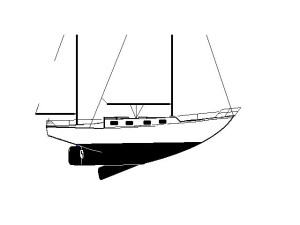Little Harbor 40 Yawl
39'11" x 11 Tons, Full Keel & Centerboard
24-Ft. Dia. Parachute Sea Anchor
Force 9-10 Conditions
File S/M-2, obtained from Charles W. Turner, Marblehead MA. - Vessel name Mambo, hailing port Marblehead, Little Harbor 40 yawl, designed by Ted Hood, LOA 39' 11" x LWL 29' 7" x Beam 11' x 11 Tons - Full keel with bronze centerboard drawing 10' 6" when down, (draft 4' 3" with board raised at sea anchor) - Sea anchor: 24-ft. diameter cargo type parachute on 120' x 1" dia. three strand rode & 1/2" swivel - Full trip line - Deployed in 1964 in deep water, approx. midway between Bermuda and Nantucket Light, within the Gulf Stream, with the wind estimated at between 40-60 knots with seas 25' and greater - Vessel's bow yawed 10° - Drift was estimated to be 40 n.m. during 12 hours at sea anchor - mainly due to the motion of the Gulf Stream.
Chapter eighteen of Coles's Heavy Weather Sailing is entitled Twice Rolled Over. It is about the trials and tribulations of the 39-ft. centerboard yawl Doubloon, whose 3/4-inch-thick bronze centerboard was "bent about 30 degrees, probably when it hit the water as the yacht came back to even keel after the roll over." Doubloon was forced to run before 60-knot winds off the Carolina coast in the spring of 1964. The skipper, Joe Byars, tried a variety of traditional tactics in an effort to "keep the sea."
First, he tried running before the wind under bare poles. It worked for a while, but after taking five full smashes from astern (resulting in one crewmember being temporarily swept overboard) he changed course and put Doubloon on a broad reach, trying to work the boat out of the storm and the Gulf Stream.
This new tactic seemed to work for a while. Three hours later, however, the yacht was unexpectedly struck by a breaking wave and knocked down on her beam end.
Byars tried lying a-hull next. With her centerboard down Doubloon lay quietly with her bow some 70° off the wind for four hours. Then, suddenly, a wave broke and rolled her completely - 360-degrees in about five seconds. Six hours later she was smash-rolled for the second time. All the crew sustained injuries - Byars broke a rib - and there was havoc down below.
The next day the crew managed to improvise "sea anchors," one of which consisted of a working jib, with the head attached to the tack to create more drag. Two mattresses were also lashed onto the remains of the stern pulpit in order to create windage aft. Doubloon took no more knockdowns.
A few months later, in June 1964, another sailboat called Mambo, practically identical to Doubloon, encountered similar conditions in the same area of the Gulf Stream, but used a parachute sea anchor. Mambo was on the homeward leg of the Bermuda Race when, at daybreak, the wind freshened from the NE and quickly built up to Force-9. This was followed by a build-up of the seas, and it wasn't long before the waves were big enough to completely blanket the wind when Mambo was in a trough.
Mambo's skipper, Charles W. Turner of Marblehead, Massachusetts, a moderately experienced sailor, had the boat running before the seas initially. A short time later, as conditions continued to deteriorate, a trusted and more experienced crewmember suggested that it seemed high time to turn the boat around and face into it.
The decision was then made to try to heave-to in the traditional way - by using sails. However severe cross-waves made it impractical to do this.
Another crewmember then pointed to the 24-ft. diameter para-anchor on the cabin sole which the owner had purchased. He stated, "Since you had us practicing with that thing off Marblehead, why not try it now?" The skipper decided that this was a good time to try it, since the man who had ridiculed it in Marblehead now appeared to favor its use.
It took three tries to accomplish proper deployment. On the first attempt the parachute blew under the bow until the keel was on top of it. It was then pulled back, straightened out and again tried. This time it flew up in the air, reaching a position where a mizzen staysail would normally be flown. It was again recovered.
On the third attempt it stayed in the water and, as the boat drifted back, it was payed out to the full length of its line, with the trip line float right above it. The line was secured to a bow cleat, although they were not sure it would hold. Mambo then faced nicely into seas of about 25-30 ft. In this posture she rode out the rest of the storm safely, albeit cork-screwing annoyingly because of the cross-seas which were running up the troughs. Mambo, tethered to the 24-ft. diameter para-anchor, sustained no knockdowns or "barrel rolls" as did her sistership, Doubloon.
Love the Drag Device Database? Help us to keep it free for all mariners by making a tiny donation to cover our server and maintenance costs. Thank You!
